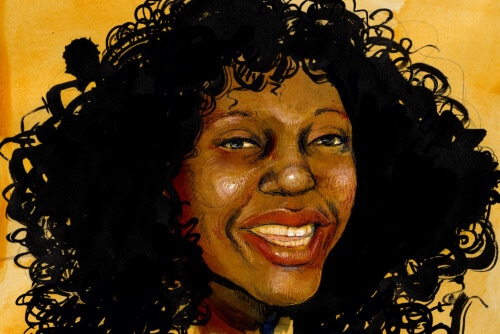Women and Oil
Women figure in news stories about oil when the depredations of the oil industry become so egregious that survival is at stake. This was the case in Escravos, in the Niger Delta region of Nigeria, in July 2002, when Nigerian women shut down the operations of ChevronTexaco.1 Their demands, which ChevronTexaco called unjustified, were for jobs, roads, houses, and embankments to stop erosion. The company’s private security force, as well as the Nigerian police, the paramilitary mobile police, the army, and the navy, protected the terminal that several hundred women managed to occupy for ten days, trapping 700 oilmen by blocking the airstrip and the docks.2 The women won concessions on the provision of electricity, water, schools, scholarships, and a community center, as well as help to set up poultry and fish farms to supply the terminal’s cafeterias.
Specific effects of oil development on women’s health seem not to have been investigated. Although I found an article on the effects of exposure of crocodiles to sub-lethal concentrations of petroleum waste drilling fluid in the Niger Delta basin, I could find nothing on the health of women who live near oil wells and oil production stations, and nothing on reproductive outcomes in areas adjacent to petrochemical plants. Yet it is known that cadmium, chromium, mercury, and lead are contained in the refinery effluents that are constantly discharged into nearby bodies of water. At high concentrations these metals cause metabolic malfunctions in human beings. They enter the food chain through the drinking water and the local fish that people consume. Fish store mercury without metabolizing it, and people who eat mercury-contaminated fish can contract Minamata disease.
Women have not traditionally moved into the top jobs of the oil and gas industry. The oil-field service industry tends to be dominated by men because engineers fill the jobs and engineering is a heavily male discipline. Men visibly outnumber women at the technical level and greatly outnumber women at the executive level. The truly influential positions are those of corporate officers who also serve on their company’s board of directors. Among all industries, such influential female insider directors are very few, and in the oil and gas industry, extremely few.3 Crude oil production and mining companies are among industries with a low representation of women corporate officers – the rate is 6.4 percent.4 Six companies (Andarko, Burlington Resources, Devon Energy, Kerr-McGee, Occidental Petroleum, and UNOCAL) employ a total of seven women officers.5
If U.S. industry analysts are to be believed, this picture represents a real improvement over the situation a decade ago. In contrast, South African women seem to be taking concerted action to change the situation in their country. There, women have formed a new organization to facilitate the participation of women in business ventures in the oil, gas, and energy sectors. The organization Women in Oil and Energy South Africa (WOESA) aims to create a platform for women to participate in these sectors nationally through training and development. The organization identifies business opportunities for its 396 members in the various provinces. WOESA coordinator Pinky Moabi says interaction takes place with industry players to create a more conducive environment for women’s empowerment and to lobby to make energy resources accessible to the poor. “We lobby policy change, facilitate access to funding, identify and provide access to relevant training, network and coordinate with members to share knowledge, and increase the presence of women in the oil, gas and energy sector. We gather and disseminate industry information, knowledge and opportunities.”6
Not being an essentialist, I cannot assert that the presence of women CEOs in the oil and gas industry would affect the policies of the major multinational petroleum companies. I can only speculate that women victims of oil development might find more opportunities to present their complaints to receptive administrators were there a critical mass of women executives in the corporations. And I hope that scientists in Nigeria and elsewhere will be moved to document the effects of oil development on women’s health.
- “Nigerian Women, in Peaceful Protest, Shut Down Oil Plant,” New York Times, July 14, 2002, late edition-final, sec. 1. [↩]
- Norinitsu Onishi, “Left Behind: As Oil Riches Flow, Poor Village Cries Out,” New York Times, December 22, 2002, late edition-final, sec. 1. [↩]
- Sara Steffes Hansen, “Why Oil Will Welcome the Good Ol’ Gals,” Oil and Gas Investor 19, no. 2 (February 1999): 39. [↩]
- Catalyst, “2000 Catalyst Census of Women Corporate Officers and Top Earners in the Fortune 500,” November 19, 2002, http://www.catalystwomen.org/press_room/factsheets/factscote00.htm. [↩]
- Randall and Dewey, the Houston-based provider of transaction and advisory services to the upstream oil and gas industry, recently named former Texaco executive Claire S. Farley as its Chief Executive Officer, possibly a first in the industry. Oil and Gas Journal 100, no. 41 (October 7, 2002): 67. Marathon Oil Corporation has one female corporate officer, its vice president of human resources. Baker Hughes has three female corporate officers, and Smith International, a Houston-based oil and gas service company, has three women. See L. M. Sixel, “No Real Formula in Figuring Number of Women Execs,” The Houston Chronicle, November 22, 2002, http://www.chron.com/cs/CDA/story.hts/business/sixel/1672643. [↩]
- “South Africa: Women Gain Entry into Male-Dominated Industry,” Mail and Guardian (Johannesburg), November 1, 2002, http://www.chico.mweb.co.za/za/archive/2002nov/021101-women.html. [↩]




